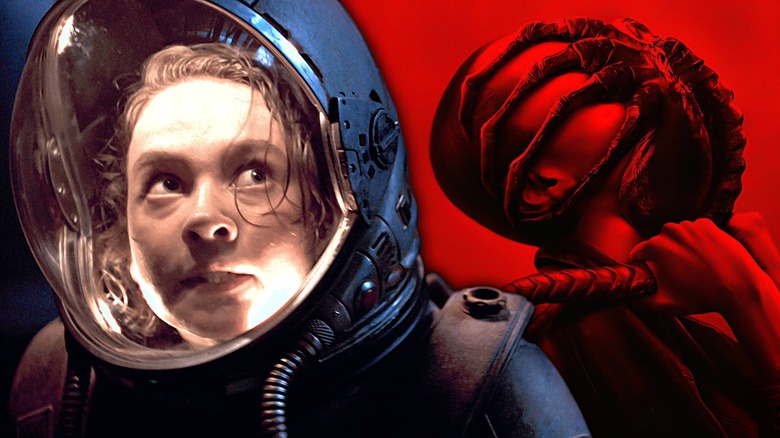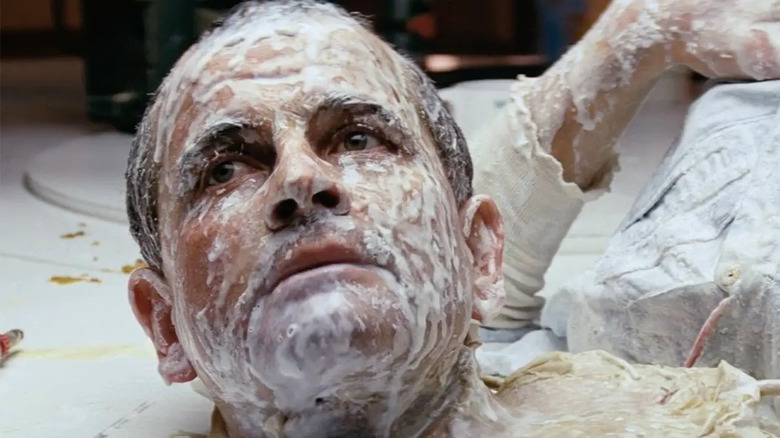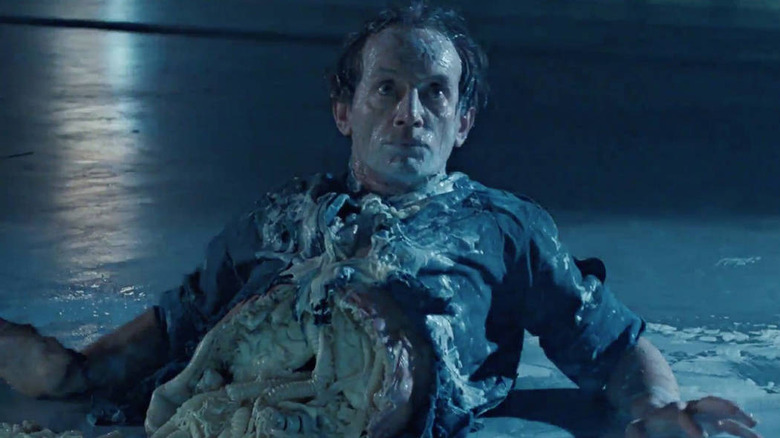The Most Controversial Moment In Alien: Romulus Repeats An Infamous Star Wars Mistake
Warning: major spoilers for "Alien: Romulus" follow.
In 2016, "Rogue One: A Star Wars Story" hit theaters with a surprising footnote: one of the film's cast members had actually been dead for 22 years. Using digital technology, the "Star Wars" prequel film was able to resurrect the late Peter Cushing as villain Grand Moff Tarkin (the movie also briefly featured a digitally resurrected Carrie Fisher, who had died that year). From a technical standpoint, the resurrected Cushing was impressive — VFX house ILM was able to place a digital version of Cushing's face over a live-actor stand-in, and for the most part, it looked believable. But there was an uncomfortable quality to the endeavour, as well as a questionable aspect of the entire idea. To quote "Jurassic Park," "Your scientists were so preoccupied with whether or not they could, they didn't stop to think if they should." Why not just cast a new actor to play the part instead of digitally summoning the dead?
"Rogue One" wasn't the first movie to take this approach, but it seemed to open the floodgates. Now that blockbuster filmmakers knew they could do this, they didn't hesitate to embrace the technology. Last year, the abysmal superhero flick "The Flash" featured an unconvincing digital recreation of the late Christopher Reeve as Superman, along with several other digitally created characters.
Now, "Alien: Romulus" is the latest blockbuster to give this concept a spin. Early in the film, characters board an abandoned space station and find a partially destroyed android. Despite its worse for wear shape (the robot has been ripped in half), the droid is still functional. And, surprise surprise, the 'bot has a familiar face. It's Ian Holm! Holm, who died in 2020, appeared in the very first "Alien" movie as Ash, an android who has nefarious goals. In "Romulus," the Holm synthetic character is Rook, and just like Ash, he's up to no good — he doesn't care if the humans get killed, he just wants to preserve some alien specimens for the evil Weyland-Yutani corporation.
A digitally resurrected Ian Holm appears in Alien: Romulus
Now, I get why "Alien: Romulus" director Fede Álvarez did this: it's a little Easter egg for fans of the original "Alien" to point at. Indeed, "Romulus" is full of Easter eggs and callbacks to previous films in the "Alien" franchise. But here's the thing: the results are awful. The recreated Holm — which seems to be a mix of a practical animatronic body and an A.I.-enhanced face — never looks convincing. Every time the film focuses on him (and it focuses on him a lot!) it's distracting and weird. It never, ever looks real. I suppose you could argue that since this is a badly damaged android it doesn't have to look like a real person, but that's a rather weak excuse.
The simple truth here is that not only does this look bad, it's a bad idea all around. It's even more frustrating when you recall that Álvarez has given interviews where he talks up the fact that "Romulus" is full of practical effects. "I knew on day one there was going to be practical effects," he told Collider. "I was going to do the old school way and that's the easy part, but to do it is the hard part." You'd think a filmmaker so keen on practical effects would realize digitally bringing back a dead man is not ideal.
To add insult to injury, there was a better, and yes, practical approach to this character. Holm isn't the only actor to play an android in the "Alien" franchise. The sequel "Aliens" introduced the android Bishop, played by character actor extraordinaire Lance Henriksen. Now, Henriksen is 84 years old, but he's also still very much alive. If the filmmakers really wanted to bring a familiar face back as a droid, why not get Henriksen?
There's no good reason to do this
All that said, I'll play devil's advocate for a moment. As mentioned above, Henriksen is in his mid-80s, so perhaps the filmmakers felt he was too old to cast in the role. Hell, perhaps they even asked him and he said no. Fair enough! But if that's the case, the next best option shouldn't be to raise the dead. Even if Álvarez and company received complete approval from Holm's relatives to bring him back in some form, it doesn't change the fact that this entire concept is just weird. It's ethically dubious at best and downright ghoulish at worst. And as already mentioned, it doesn't look convincing.
Nicolas Cage, an actor who is thankfully still with is, also appeared in the aforementioned "The Flash" in a digitally enhanced form as a Superman from an alternate dimension. The actor recently revealed that he was set to be "digitally scanned" for his role in the upcoming live-action "Spider-Man Noir" streaming series. "Well, they have to put me in a computer and match my eye color and change — I don't know," Cage told The New Yorker. "They're just going to steal my body and do whatever they want with it via digital A.I. ... God, I hope not A.I. I'm terrified of that. I've been very vocal about it." He added:
"And it makes me wonder, you know, where will the truth of the artists end up? Is it going to be replaced? Is it going to be transmogrified? Where's the heartbeat going to be? I mean, what are you going to do with my body and my face when I'm dead? I don't want you to do anything with it!"
I'm sure the technology to recreate actors will only improve as time goes on, but that doesn't mean filmmakers should keep using it. In the end, no matter how you slice it, there's no logical reason why a living actor couldn't have been cast in the role of the android Rook instead of using an unconvincing A.I. deep fake Ian Holm.


